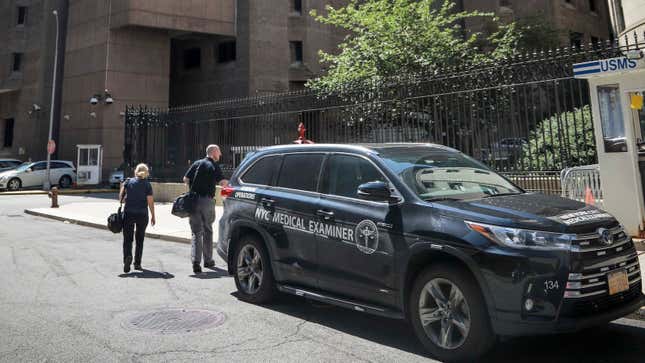Medical Examiner Quoted in Washington Post Story Suggesting Epstein Could Have Been Strangled Has Some Fairly Urgent Clarifications
Latest

This story contains graphic descriptions concerning a method of suicide.
On Thursday, the Washington Post published an immediately viral report, in which two sources said the autopsy of dead pedophile and accused sex trafficker Jeffrey Epstein showed he had sustained a broken hyoid bone in his neck when he died. A broken hyoid, the Post reported, is “more common in victims of homicide by strangulation” than it is in suicidal hanging. Predictably, given the conspiracy theories already swirling around Epstein’s death, everyone lost their minds. But on Friday, the medical expert quoted in the story issued a statement clarifying—again—that it’s entirely possible to break the hyoid in a hanging, especially among older men.
The framing of the Post story claimed that the broken hyoid bone, a U-shaped bone located near the Adam’s apple in men, was “deepening” the questions around Epstein’s death. While it made sure to note that hyoids can also be broken in hangings, it was still, at its heart, a cautious and respectable way to float a conspiracy theory. The sole medical expert quoted was Jonathan L. Arden, the president of the National Association of Medical Examiners, who wasn’t involved in the Epstein autopsy. As everyone on Twitter became an expert on broken neck bones, Arden issued a clarification, reported by Oliver Darcy of CNN, stating that broken hyoids are “well recognized also to occur in suicidal hangings.”
CNN spoke with four other medical experts, who all said it’s perfectly possible for a hyoid to break during a suicide. Jeremy Samuel Faust, an emergency medicine physician writing for Slate, pointed out just how statistically insignificant the broken hyoid is:
If a broken hyoid bone was rarely or never associated with death by hanging, then there might be something here. But in the study cited by the Washington Post itself, 25 percent of patients who died by suicidal hanging had broken hyoids. That’s not a small number. Also, the average age of patients with this finding was 61 (Epstein was 66), much older than those in the study without broken hyoids.
A Post spokesperson told CNN that their story “makes absolutely clear from the beginning that suicide remains a distinct possibility… What we said throughout the piece is that this requires greater investigation.”
All the Post story really shows—besides the fact that Epstein was an old man—is how astonishingly close the conspiratorial impulse is to the mainstream in this case. And deep-in-the-weeds conspiracy theorists truly loved the Post report; QAnon promoter Jordan Sather tweeted a link, with an added insinuation about strangulation.
There’s no real way to reel back in the avalanche of speculation that the Post story triggered, and any efforts to do so will be taken to be part of the conspiracy. In the meantime, two more women have filed lawsuits against Jeffrey Epstein’s estate, saying they were assaulted by him during massages at his Manhattan mansion when they were 18 and 20 years old. In the midst of intense focus on a tiny bone in a dead man’s neck, his living conduct is still, in the end, where the real scandal lies.
The National Suicide Prevention Lifeline provides 24/7, free and confidential support for people in distress. Reach them at 1-800-273-8255.